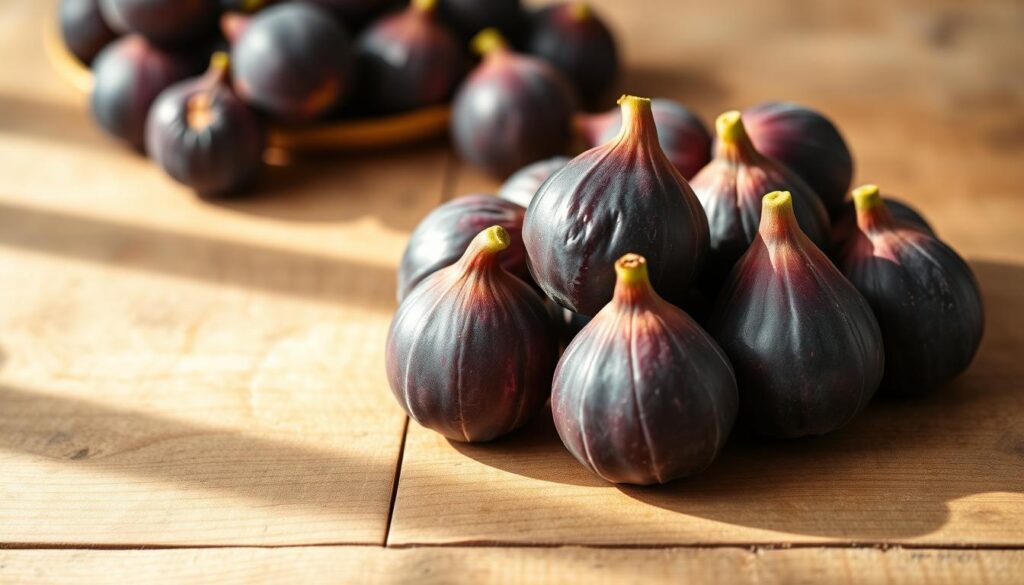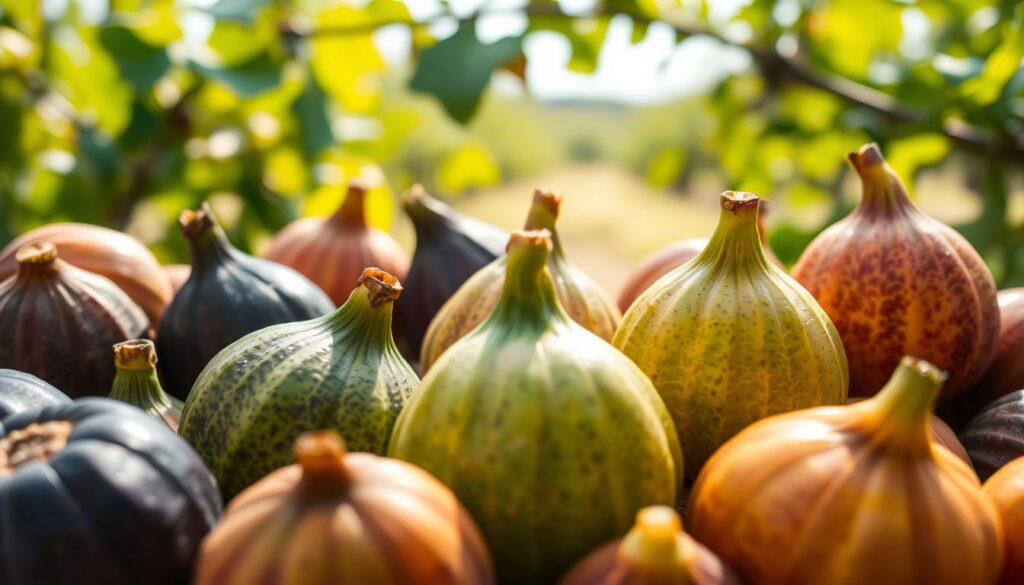Figs are more than just a sweet treat. They are packed with fiber and natural sweetness. This makes them a great choice for those watching their blood sugar or looking for natural sweeteners. Let's see how figs can help balance your diet while pleasing your taste buds.

Figs are a natural sweetener that's rich in fiber. Their nutrients help slow down sugar absorption. This keeps blood sugar levels stable. Whether you prefer them dried or fresh, figs add flavor without causing spikes in blood sugar.
Key Takeaways
- Figs are high in fiber, aiding digestion and blood sugar regulation.
- Natural sweetness in figs reduces reliance on processed sugars.
- They offer vitamins and minerals alongside heart-healthy nutrients.
- Fiber content helps keep energy levels steady throughout the day.
- Easy to incorporate into both sweet and savory dishes.
Introduction to Figs: Nature's Ancient Sweet Treat
Figs are more than just a snack—they're a ancient fruit with a long history. They've been around for thousands of years, enjoyed in the Mediterranean and Middle East. Now, they're gaining popularity among those who care about their health.
The Historical Significance of Figs
Archaeologists found figs dating back to 9400 BCE. This makes them one of the first crops humans domesticated.
“The fig is the tree that came first,”
old texts say. They were sacred in Greece and Egypt. Figs were traded, used in medicine, and stood for fertility in rituals.
Why Figs Are Making a Comeback in Modern Nutrition
Today, nutritionists love figs as a natural sweetener without refined sugars. They're part of the Mediterranean diet, which is popular for whole foods. Research shows they help the heart, making them trendy again.
Overview of Fig's Nutritional Profile
Each fig is packed with:
- Vitamin K and calcium for strong bones
- Potassium to keep blood pressure in check
- Natural sugars for energy without the highs and lows
These ancient fruit offer more nutrients than many modern snacks.
The Nutritional Powerhouse of Figs
Figs are packed with vitamins and minerals that boost everyday health. They are a nutrient-rich choice for many reasons.
Essential Vitamins and Minerals in Figs
Figs are full of important nutrients. They have potassium for heart health, calcium for strong bones, and vitamin K for blood clotting. A 100g serving gives you:
- 14% of daily potassium needs
- 1.5% calcium (more when dried)
- 5% vitamin K
Fiber Content: The Star Component
Dietary fiber is key in figs. They have both soluble and insoluble fiber. Here's a comparison:
| Fruit | Serving Size | Dietary Fiber (g) |
|---|---|---|
| Fresh Figs | 100g | 2.6g |
| Dried Figs | 100g | 6.7g |
| Apple | 100g | 2.4g |
| Banana | 100g | 2.6g |
Dried figs have more fiber, making them a great snack.
Antioxidant Properties of Figs
Figs are full of antioxidants in figs like phenols and carotenoids. These fight free radicals and reduce inflammation. They are as good as berries in antioxidants.
“Figs’ antioxidant mix supports long-term cellular health,” says the USDA Agricultural Research Service.
Figs are a science-backed addition to any diet. They offer vitamins, fiber, and antioxidants. This makes them a versatile food for meals.
How Figs Help Moderate Blood Sugar Levels
Figs taste sweet but their sugars act differently than processed foods. They have a low glycemic index, which means they release glucose slowly. This helps control blood sugar levels, especially for those with type 2 diabetes.
Their high fiber content is the key. Fiber in figs traps sugars, slowing digestion and preventing blood sugar spikes. This improves insulin sensitivity, helping cells absorb glucose better.
Eating figs with meals can keep sugar levels stable. A 2022 study in the Journal of Nutrition found figs lowered blood sugar rises by 20% compared to refined carbs. The fiber in figs also feeds gut bacteria, boosting metabolic health over time.
- Figs rank 59 on the glycemic index—lower than bananas (51) and grapes (46).
- 3 grams of fiber per 2-inch fig slow sugar absorption, reducing insulin spikes.
"Figs' unique fiber profile makes them a safe fruit choice for blood sugar management," says Dr. Emily Carter, a diabetes nutrition specialist.
To control blood sugar best, eat figs with protein or healthy fats. Their natural sweetness satisfies cravings and supports insulin sensitivity long-term. Whether dried or fresh, figs are a smart choice for managing blood sugar swings.
The Fig: A Closer Look at This Unique Fruit
Figs are more than just sweet treats. They are botanical wonders. Each fruit is a syconium, an inverted flower cluster with hundreds of tiny blooms. This makes them a curiosity in the botanical world. They have a special relationship with fig wasps for pollination in the wild. Let's dive into what makes figs so special.

“Figs are the only fruit that’s eaten with the flower and seeds inside.”
Botanical Classification and Structure
Figs are scientifically known as Ficus carica. They grow on trees or shrubs. Their unique shape is due to flowers hidden inside their fleshy walls. This design protects seeds and attracts pollinators, making them a natural wonder.
Popular Fig Varieties in the United States
These fig varieties are loved in the US:
- Black Mission figs: Dark purple skin with rich, honeyed flesh—ideal for baking or snacks.
- Calimyrna figs: Golden-green skin and a nutty taste, often used for dried figs.
- Brown Turkey figs: Large, teardrop-shaped fruits with a mild, juicy flavor perfect for salads.
- Kadota figs: Creamy interiors with minimal seeds, popular in preserves.
Fresh vs. Dried Figs: Nutritional Differences
Fresh figs are full of water and vitamin C. Dried figs have more fiber and potassium. Drying them concentrates nutrients but keeps antioxidants. Both are sweet without added sugars!
Selecting and Storing Figs for Maximum Freshness
To enjoy figs at their best, you need to know how to pick and store them. These delicate fruits require care from start to finish. This ensures you get the most flavor and nutrients.
"The key is balancing ripeness without sacrificing texture," advises a California fig farmer. "Look for figs that yield gently under your touch."
How to Choose Ripe Figs
Choose ripe figs by their plump shape and even color. Deep purple for Mission or amber for Kadota varieties. Avoid figs with bruised skin or soft spots. For dried figs, they should be flexible, not brittle.
Proper Storage Techniques
Learn how to store figs properly:
- Refrigerating figs: Store unwashed fresh figs in a breathable container in the fridge for 2–3 days.
- Freezing figs: Slice and freeze on a tray before transferring to a ziplock bag for up to 6 months. Perfect for baking later!
- Dried figs: Keep in airtight containers away from light to prevent drying out.
Extending Fig Shelf Life
During fresh fig season (late summer to early fall), enjoy figs more by:
- Freezing whole or halved figs for smoothies or desserts.
- Making quick syrup or jams to use later.
- Using refrigerating figs immediately if eating within a few days.
Follow these tips to enjoy figs' natural sweetness all year.
Delicious Ways to Incorporate Figs into Your Diet
Figs are great for adding flavor to your meals and snacks. Try a warm oatmeal with sliced figs and honey for breakfast. Or, make a yogurt parfait with granola and fresh figs. You can also blend them into smoothies for a sweet touch.
- Pair grilled fig halves with prosciutto for a quick appetizer.
- Mix chopped figs into chicken salad or as a glaze for roasted meats.
- Add dried figs to trail mix for an energy-boosting snack.
A salad with figs is amazing with arugula, crumbled feta, walnuts, and balsamic dressing. For savory fig dishes, top flatbread with caramelized figs, goat cheese, and caramelized onions before baking. Don’t forget fig desserts—roast them with cinnamon for a warm compote or mix into muffin batter for a sweet surprise.
“Figs marry well with bold flavors like blue cheese, dark chocolate, and spicy mustard.”
Try figs in both sweet and savory dishes to make them a regular part of your diet. Their sweetness balances out the richness in meats and makes desserts even better. Get creative and enjoy the flavors!
Fig Season: When to Find the Freshest Fruit
Fig harvest season has two peak times for enjoying these sweet fruits. Knowing when to look for summer and fall figs is key. We'll look at the best times and places to find California figs and other local varieties.
Most figs grow two crops a year. The first, called the breba crop, comes in summer figs from June to August. These are softer and less common. The main harvest comes later, in late summer and fall, with sweeter, firmer fruit perfect for baking or drying.
- Summer figs (June–August): Breba crop, best for fresh eating.
- Fall figs (August–October): Main crop, ideal for cooking or preserving.
California figs make up over 98% of U.S. supply. But, growers in Texas, Florida, and the Southeast also contribute. For seasonal eating, look for local figs at farmers’ markets or CSAs:
“Buying local figs at their peak means better flavor and less travel time,” says a California grower. “Check your farmers’ market schedule for harvest updates.”
Plan your shopping:
- Summer: Look for summer figs in June–August in southern states.
- Fall: Find fall figs nationwide, with California leading supply.
- Winter: Opt for dried or imported options when fresh local figs are scarce.
Choose local figs to support farms and reduce your carbon footprint. Seasonal eating means better nutrition and taste!
Potential Side Effects and Considerations

Figs are good for you, but there are a few things to watch out for. Here's how to make sure you enjoy them without any issues.
Digestive Effects of High Fig Consumption
Figs can cause digestive problems because they're so high in fiber. Eating too many can lead to bloating or loose stools. To stay comfortable:
- Start with small portions.
- Pair figs with water to aid digestion.
- Choose dried figs in moderation—they pack more fiber per serving.
Fig Allergies and Sensitivities
Some people might be allergic to figs, especially if they have latex-fruit syndrome. This can cause itching or swelling. Common allergens include:
- Kiwi
- Bananas
- Mangoes
If unsure, consult a healthcare provider before adding figs to your diet.
Medication Interactions
Figs have vitamin K, which can affect blood thinners like warfarin. This might change how your blood clots. Always tell your doctor if you're taking these meds.
| Medication Type | Potential Interaction | Advice |
|---|---|---|
| Blood thinners | Varying clotting times | Discuss intake with a healthcare professional |
| Diabetes medications | May enhance blood sugar control | Monitor levels closely |
Being aware is important! Enjoy figs in a balanced diet. Adjust how much you eat based on your own needs.
Figs vs. Other Fruits: A Nutritional Comparison
Figs are not just a unique fruit; they also compare well to dates and prunes. This fruit comparison shows how figs rank in important areas like fiber content in fruits and natural sugar in fruit. Let's see how they compare.
- Fiber content in fruits: Figs have 2-3g per dried piece, a bit less than prunes (6g) but more than dates (2g).
- Natural sugar in fruit: Figs and dates are sweet, but figs have less sugar. Figs have 19g of sugar per 100g, while dates have 61g.
- Vitamins: Figs are high in calcium; prunes are rich in vitamin K.
In dates vs figs, both are great for energy, but figs have less sugar and more calcium. Dates are high in fiber, perfect for quick energy. For prunes vs figs, prunes have more fiber but less calcium. Both help with digestion, but prunes have more antioxidants.
Pair figs with other fruits for balanced nutrition and taste. Mix dried figs with almonds for crunch or add prunes to oatmeal for a fiber boost.
Each fruit has its own benefits. Figs are rich in calcium, while dates and prunes offer different advantages. Choose based on your goals—whether it's lowering sugar, boosting fiber, or enjoying natural sweetness without too many calories.
Fig Recipes to Try at Home
Make figs into tasty meals that are good for you. They add sweetness and fiber, helping control blood sugar. Try these simple recipes for any time of day.
Sweet Fig Recipes
Start your day with:
- Honey-Baked Figs with Yogurt: Roast halved figs with honey and thyme until tender. Serve over Greek yogurt for a fiber-rich breakfast. (2g fiber per serving)
- Fig Cake: Mix mashed figs, almond flour, and vanilla extract into a moist cake. Top with lemon zest for a gluten-free treat.
- Fresh Fig Tart: Layer sliced figs over an almond crust with orange zest. A no-sugar-added dessert with 3g fiber per slice.
Savory Fig Dishes
Add figs to mains and fig appetizers:
- Fig-Stuffed Pork Tenderloin: Stuff pork with dried figs, walnuts, and rosemary. Roast until juices run clear.
- Fig and Arugula Salad: Toss arugula with roasted figs, blue cheese, and balsamic dressing. A crisp, protein-packed lunch.
- Caramelized Fig Flatbread: Top dough with caramelized onions, goat cheese, and fig slices. Bake until bubbly for a quick fig appetizer.
Fig Preserves and Condiments
Extend fig season with:
- Fig Jam: Simmer fresh figs with lemon juice and cinnamon. Store in jars for preserving figs year-round.
- Fig Chutney: Cook figs with apples, ginger, and vinegar. Serve with cheese or grilled chicken.
- Fig-Infused Vinegar: Steep dried figs in vinegar for 2 weeks. Use in dressings or marinades.
Conclusion: Making Figs a Regular Part of Your Healthy Diet
Figs are more than a sweet treat. They are a natural food full of fiber and antioxidants. They help keep blood sugar levels in check, making them great for a healthy diet. You can enjoy them fresh or dried, adding them to yogurt, smoothies, or cheese for a quick snack.
Getting figs might seem hard, but dried figs last longer and are easy to grab on the go. Buy them when they're in season and freeze any extras. This way, you can easily add figs to your diet, even on a tight budget. Studies show their benefits, but their long history proves they're a timeless choice.
Try out the recipes we mentioned to find new ways to enjoy figs. They're great for baking, grilling, or just eating plain. Let figs be a key part of your diet, blending old wisdom with modern health goals. Your body and taste buds will love it.
FAQ
What are the main health benefits of figs?
Figs are packed with fiber, antioxidants, vitamins, and minerals. They help with digestion, control blood sugar, and boost overall health. Their fiber slows down sugar absorption, and antioxidants fight body stress.
How do fresh figs differ from dried figs in terms of nutrition?
Fresh figs have more water and less sugar than dried figs, making them lower in calories. Dried figs, however, have a higher nutrient concentration, including more sugar and fiber. Both types offer health benefits, depending on your preference and use.
How should I store figs to keep them fresh?
Keep fresh figs in the fridge in a breathable container. Eat them within a few days for the best taste. Store dried figs in an airtight container in a cool, dark place to keep their texture and prevent crystallization.
Can figs help with blood sugar control for diabetics?
Yes, figs can help manage blood sugar levels. Their fiber content is beneficial for those with diabetes. They have a low glycemic index, meaning they won't cause blood sugar spikes when eaten in moderation.
Are there any potential side effects of consuming figs?
Figs are generally safe, but high fiber intake can cause digestive issues for some. People with latex allergies should be cautious, as figs can trigger cross-reactions.
What are popular fig varieties available in the U.S.?
In the U.S., popular fig varieties include Black Mission, Calimyrna, Brown Turkey, and Kadota. Each variety offers a unique taste and texture, perfect for various dishes, from fresh eating to baking.
How do I know when figs are ripe?
Ripe figs are slightly soft, have a rich color, and smell sweet. Avoid firm or mushy figs, as they're not ideal for eating.
Can figs be incorporated in cooking and baking?
Yes! Figs are great in salads, smoothies, and both sweet and savory dishes. They pair well with cheeses, nuts, and grains, making them a versatile kitchen ingredient.
Are figs good for weight management?
Figs can aid in weight management due to their fiber content. This fiber promotes fullness, supporting healthy eating habits while enjoying their natural sweetness.
How does the fiber in figs benefit digestion?
The fiber in figs aids digestion by promoting regular bowel movements and preventing constipation. It also supports gut health by feeding beneficial gut bacteria.
